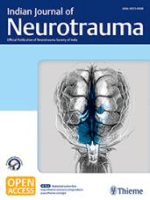
Brain Circulation
Scope & Guideline
Uniting Global Minds for Neurovascular Progress
Introduction
Aims and Scopes
- Cerebrovascular Disorders:
The journal emphasizes research on cerebrovascular diseases, including ischemic and hemorrhagic strokes, exploring both the underlying mechanisms and treatment methodologies. - Neurocritical Care:
There is a strong focus on neurocritical care practices, including the management of patients with severe neurological injuries and the development of new protocols for treatment. - Innovative Therapeutic Approaches:
The journal publishes studies on innovative therapies such as mechanical thrombectomy, neuroprotective strategies, and the use of advanced imaging techniques in diagnosing and treating neurological conditions. - Neurorehabilitation:
Research on rehabilitation strategies for patients recovering from neurological events, including stroke, is a core area, emphasizing the importance of functional recovery and quality of life. - Biomarkers and Predictive Models:
The journal explores the role of biomarkers in predicting outcomes for neurological diseases, providing insights into the pathophysiology and potential therapeutic targets. - Interdisciplinary Approaches:
'Brain Circulation' encourages interdisciplinary research that combines neurology with other fields such as cardiology, immunology, and rehabilitation sciences.
Trending and Emerging
- Telemedicine and Remote Monitoring:
The rise of telehealth practices, especially in the context of neurological care, is increasingly being explored, highlighting the importance of remote monitoring for patient management. - Neuroinflammation and Immune Response:
Research focusing on the role of neuroinflammation in various neurological disorders is trending, emphasizing its significance in conditions such as stroke and neurodegenerative diseases. - Wearable Technology and Digital Health:
There is a growing interest in the application of wearable technology to monitor neurological health and rehabilitation outcomes, reflecting a trend towards personalized medicine. - COVID-19 and Neurological Impacts:
Studies investigating the neurological implications of COVID-19, including long-term effects and mechanisms of action, have surged, illustrating the pandemic's influence on neurological research. - Integrative and Alternative Therapies:
The exploration of integrative approaches, such as acupuncture and dietary interventions, in managing neurological conditions is becoming more prominent, reflecting a holistic view of patient care.
Declining or Waning
- Traditional Pharmacological Therapies:
There has been a noticeable decrease in studies focused solely on traditional pharmacological treatments for neurological disorders, as the field shifts towards more integrative and innovative approaches. - Basic Science Research:
While foundational studies are essential, there appears to be a waning focus on purely basic scientific research without direct clinical implications, as the journal increasingly prioritizes translational research. - Case Reports:
The frequency of case reports has declined, likely due to a growing preference for larger cohort studies and systematic reviews that provide broader insights into treatment efficacy and patient outcomes. - Historical Reviews:
There is a diminishing interest in historical reviews of neurological practices, as the field looks forward to novel interventions rather than retrospective analyses.
Similar Journals

CURRENT NEUROVASCULAR RESEARCH
Connecting Minds: Insights into Neurovascular ResearchCURRENT NEUROVASCULAR RESEARCH is an esteemed peer-reviewed journal published by Bentham Science Publishers Ltd, focusing on the intricate relationships within the realms of cellular and molecular neuroscience, developmental neuroscience, and neurology. With an ISSN of 1567-2026 and an E-ISSN of 1875-5739, this journal has been contributing to the field since its inception in 2004 and is poised to continue through 2024. As a resource dedicated to disseminating innovative research findings, CURRENT NEUROVASCULAR RESEARCH is recognized within Category Quartiles as Q3 in multiple fields, including Neurology (clinical) and Developmental Neuroscience. Although classified in the Q4 category for Cellular and Molecular Neuroscience, the journal maintains a crucial role in fostering academic discourse and advancing our understanding of neurovascular dynamics. Researchers, professionals, and students will find valuable insights in this journal, offering access to a diverse range of studies that highlight cutting-edge developments in the field.

EUROPEAN JOURNAL OF NEUROLOGY
Elevating Knowledge in Neurohealth and Clinical Practice.EUROPEAN JOURNAL OF NEUROLOGY, published by WILEY, stands as a leading platform for the dissemination of innovative research and clinical developments in the field of neurology. With a robust impact factor and prestigious rankings, including being positioned as Q1 in both Neurology and Clinical Neurology categories, the journal plays a pivotal role in shaping neurological sciences from 1994 to 2024. Its Scopus rank highlights its importance, being in the 88th percentile for clinical neurology and 87th percentile for neuroscience. Located in the United Kingdom, the journal thrives as a vital resource for researchers, clinicians, and students dedicated to improving neurological health outcomes. Although it does not offer Open Access, its subscription-based model ensures high-quality peer-reviewed articles are accessible to a global audience, reflecting the continuous pursuit of excellence in neurological research and patient care.

Indian Journal of Neurotrauma
Exploring the complexities of neurotrauma management.Indian Journal of Neurotrauma is a premier Open Access journal published by GEORG THIEME VERLAG KG, dedicated to advancing the field of neurotrauma through rigorous research and comprehensive scholarly discourse. With an ISSN of 0973-0508 and E-ISSN 2213-3739, this journal provides a vital platform for researchers, clinicians, and students to share findings and insights on the multifaceted aspects of neurotrauma, including its clinical management, epidemiology, and innovative treatment approaches. Since adopting an Open Access model in 2020, the journal has enhanced its accessibility, ensuring that groundbreaking studies and critical reviews are available to a wider audience, thereby fostering collaboration and innovation. The Indian Journal of Neurotrauma aims to serve as a comprehensive resource for those involved in public health, neurology, and trauma care, making significant contributions to the understanding and treatment of neurotrauma globally.

CEREBROVASCULAR DISEASES
Transforming research into improved patient outcomes.CEREBROVASCULAR DISEASES is a prestigious journal published by KARGER that focuses on the critical field of cerebrovascular health, encompassing research and advancements in cardiology and neurology. With a strong emphasis on high-quality, peer-reviewed publications, the journal has established itself as an essential resource since its inception in 1987, contributing to the understanding and management of cerebrovascular disorders. It holds a commendable Q2 ranking across various categories, including Cardiology and Cardiovascular Medicine, which underscores its influence within the research community. The journal is especially significant for professionals and researchers interested in the intersection of neurological and cardiovascular health, facilitating knowledge sharing and innovative research. Although it does not operate under an Open Access model, the journal is well-regarded for its rigorous selection criteria and impactful findings. By continuing to publish cutting-edge research, CEREBROVASCULAR DISEASES aims to foster advancements in treatment and prevention strategies for cerebrovascular diseases, thereby contributing to improved patient outcomes worldwide.

JOURNAL OF THE NEUROLOGICAL SCIENCES
Unveiling the latest discoveries in neurological sciences.JOURNAL OF THE NEUROLOGICAL SCIENCES, published by Elsevier, is a leading academic journal that has been at the forefront of neurology research since its inception in 1964. With a robust scope covering both clinical and experimental neurological sciences, this journal serves as an invaluable resource for researchers, practitioners, and students in the field. The journal is indexed with an impressive Q2 ranking in Neurology and a remarkable Q1 status in Clinical Neurology as of 2023, reflecting its high impact and relevance in the medical community. The journal's Scopus rankings further emphasize its significance, holding the 69th position in clinical neurology and 35th in neuroscience, marking it in the top 82nd percentile of its peers. While the journal operates under a traditional subscription model, it continues to offer a platform for groundbreaking research and comprehensive reviews that advance our understanding of neurological disorders. Researchers and clinicians alike will find the JOURNAL OF THE NEUROLOGICAL SCIENCES an essential contribution to the literature, paving the way for innovations in clinical practices and therapeutic strategies.

Seminars in Pediatric Neurology
Fostering collaboration between researchers and clinicians.Seminars in Pediatric Neurology, published by W B SAUNDERS CO-ELSEVIER INC, is a prestigious journal dedicated to the evolving field of pediatric neurological disorders. Since its inception in 1994, this peer-reviewed journal has provided critical insights and cutting-edge research to support healthcare professionals in enhancing the quality of care for children with neurological conditions. With an impressive 2023 impact factor and a Q2 ranking in both the clinical neurology and pediatrics categories, it stands as a vital resource, fostering the dissemination of knowledge among researchers and clinicians alike. Featuring articles that explore a range of topics from clinical trials to innovative treatment modalities, this journal empowers practitioners with the latest findings in pediatric neurology. While primarily subscription-based, it plays a key role in bridging the gap between academia and clinical practice, making it an indispensable tool for anyone involved in the care and treatment of pediatric neurological patients.

European Stroke Journal
Connecting researchers and clinicians for impactful stroke solutions.The European Stroke Journal, published by SAGE Publications Ltd, is a pivotal resource in the domains of Cardiology and Neurology, reflecting its commitment to advancing knowledge and research in these critical areas of medicine. Since its inception in 2016, this journal has rapidly gained recognition, achieving a prestigious Q1 ranking in both Cardiology and Neurology (clinical) as of 2023, placing it among the top quartile publications in these fields. With a prominent position, ranked 65th and 72nd respectively in Scopus for Cardiology and Neurology, the journal caters to a diverse audience of researchers, clinicians, and students dedicated to improving stroke treatment and prevention strategies. Although it operates under a traditional access model, its impactful publications are essential for anyone involved in stroke research, ensuring they remain at the forefront of scientific developments and clinical practices.

Stroke-Vascular and Interventional Neurology
Transforming stroke care with cutting-edge insights.Stroke-Vascular and Interventional Neurology, published by WILEY, is a leading open-access journal dedicated to advancing the field of neurology with a particular focus on stroke and vascular interventions. Since its inception in 2021 as an open-access journal, it has fostered a collaborative environment for researchers, clinicians, and educators to share innovative findings and clinical practices that address the complexities of cerebrovascular diseases. The journal emphasizes high-quality, peer-reviewed research articles, reviews, and case studies, providing critical insights into cutting-edge therapies and surgical techniques. With an ISSN of 2694-5746, it aims to support the global medical community in improving the diagnosis, treatment, and overall management of stroke patients. Researchers and healthcare professionals benefit from its accessible content, which is vital for fostering comprehensive understanding and evidence-based practices within the realm of interventional neurology.

Cerebrovascular Diseases Extra
Bridging Knowledge Gaps in Cerebrovascular HealthCerebrovascular Diseases Extra is a distinguished open-access journal published by KARGER, operating out of Switzerland since 2011. With ISSN 1664-5456, this journal aims to bridge the gap in knowledge surrounding cerebrovascular diseases, an essential segment of both Cardiology and Cardiovascular Medicine as well as Neurology. Ranked in the third quartile by Scopus for various categories, including Cardiology, Neurology, and Clinical Neurology, it is specially designed for academics, clinicians, and researchers who seek to disseminate and gain insights into the latest advancements and research findings in these critical areas. By embracing open access, it amplifies the reach and impact of its published research, ensuring that vital information is readily accessible to a global audience. As the journal converges towards its targeted years from 2015 to 2024, it remains a pivotal platform for fostering innovative ideas and collaborative research in cerebrovascular health.

Journal of Stroke & Cerebrovascular Diseases
Connecting Research with Clinical ExcellenceJournal of Stroke & Cerebrovascular Diseases, published by ELSEVIER, is a leading international peer-reviewed journal dedicated to advancing the research and understanding of stroke and cerebrovascular disorders. With an impressive impact factor reflective of its rigorous academic standards, this journal is indexed in the highest echelons of medical disciplines, boasting a Q1 classification in Rehabilitation and prominent rankings in related fields. Established in 1991 and converging its focus toward 2024, it serves as a vital resource for researchers and clinicians interested in the complexities and treatment of cerebrovascular conditions. The journal's broad scope spans essential categories such as cardiology, neurology, and surgery, making significant contributions that enhance clinical practices and patient outcomes. For researchers, professionals, and students alike, the Journal of Stroke & Cerebrovascular Diseases is not just a publication but a critical platform for sharing innovative findings and fostering impactful discussions within the medical community.